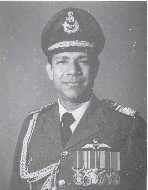SLAF History : The Sixth Commander

 The early 1980's in the SLAF seemed no different to the era just gone by. Life went on with no turbulence yet this was in hindsight a largely deceptive scenario had appeared on the horizon and was moving slowly but inexorably to form the darkest hours.
The early 1980's in the SLAF seemed no different to the era just gone by. Life went on with no turbulence yet this was in hindsight a largely deceptive scenario had appeared on the horizon and was moving slowly but inexorably to form the darkest hours.On 1st May 1981 Air Vice Marshal Dick Cuthbert Perera succeeded Air Vice Marshal Harry Goonetileke as Commander of the Air Force.AVM Perera continued where AVM Goonetilleke left off, in reclaiming disused airfields and runways, across the country.
The Commander began by establishing SLAF units at Batticaloa, Anuradhapura, Koggala and Sigiriya. The records show that these disused airfields were vested under the control of the SLAF on the directive of His Excellency the President of Sri Lanka, during the year 1982.
 In general, these airfields were re-activated for the first time after World War II, to provide security to all visiting aircraft, and for the maintenance of the airfields for safe operation of aircraft to and from them. All these new airfields came directly under the purview of the Directorate of Ground Operations, at the time.
In general, these airfields were re-activated for the first time after World War II, to provide security to all visiting aircraft, and for the maintenance of the airfields for safe operation of aircraft to and from them. All these new airfields came directly under the purview of the Directorate of Ground Operations, at the time. Of these, perhaps the one with the richest heritage in aviation terms would be Koggala. The RAF came to Koggala in 1938 and built the camp and airfield. Koggala was in many ways an ideal base for the amphibious sea planes of the RAF, as there was plenty of water surrounding the airfield shrouded in vegetation, providing ideal camouflage conditions. The reopening of these airfields, must go down in history, as Air Vice Marshal Dick Perera's most singular contribution to the country as Commander of the Air Force.















